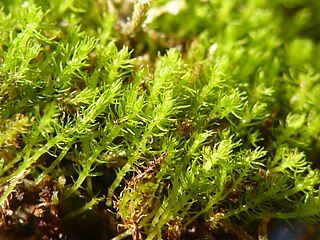
Takakia is a genus of two species of mosses known from western North America and central and eastern Asia. The genus is placed as a separate family, order and class among the mosses. It has had a history of uncertain placement, but the discovery of sporophytes clearly of the moss-type firmly supports placement with the mosses.
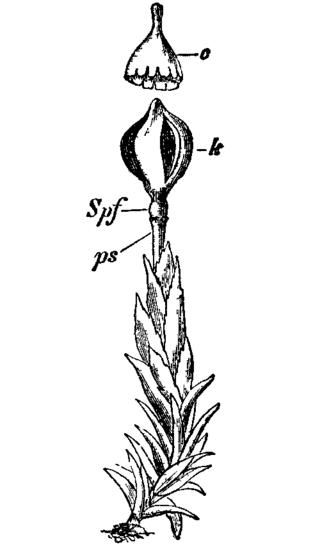
Andreaeaceae is a family of mosses which includes two genera, Andreaea, containing about 100 species, and the genus Acroschisma. The Andreaeaceae prefer rocky habitats ranging from tropical to arctic climates, on which they form tufted colonies, typically with reddish to blackish shoots. The capsules lack the peristome mechanism and dehisce longitudinally to release the spores, resulting in a paper-lantern appearance.
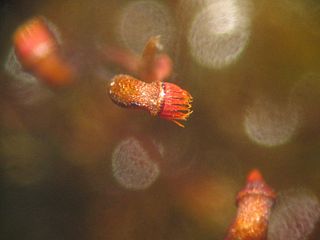
The Bryopsida constitute the largest class of mosses, containing 95% of all moss species. It consists of approximately 11,500 species, common throughout the whole world.

Buxbaumia is a genus of twelve species of moss (Bryophyta). It was first named in 1742 by Albrecht von Haller and later brought into modern botanical nomenclature in 1801 by Johann Hedwig to commemorate Johann Christian Buxbaum, a German physician and botanist who discovered the moss in 1712 at the mouth of the Volga River. The moss is microscopic for most of its existence, and plants are noticeable only after they begin to produce their reproductive structures. The asymmetrical spore capsule has a distinctive shape and structure, some features of which appear to be transitional from those in primitive mosses to most modern mosses.

Diphyscium is a genus of mosses in the family Diphysciaceae. Members of this genus are small, perennial plants. The capsule does not elongate much, and remains buried among surrounding leaves.

The Funariidae are a widespread group of mosses in class Bryopsida. The majority of species belong to the genera Funaria and Physcomitrium.
Neckeropsis is a genus of plant in the family Neckeraceae.
Platyhypnum is a genus of mosses in the family Amblystegiaceae.

Andreaeobryum is a genus of moss with a single species Andreaeobryum macrosporum, endemic to Alaska and western Canada. The genus is placed as a separate family, order and class among the mosses.
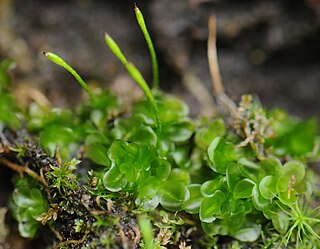
Oedipodium is the only genus of moss in the family Oedipodiaceae. It contains the single species Oedipodium griffithianum, the gouty-moss or Griffith's oedipodium moss. This species is distributed in cooler climates of Eurasia, as well as from Alaska, Washington state, British Columbia, Yukon, Greenland, Newfoundland, Tierra del Fuego and the Falkland Islands.
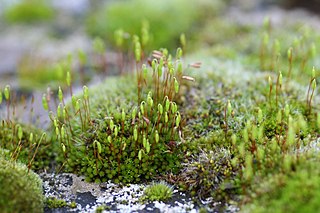
Bryales is an order of mosses.

Timmia is a genus of moss. It is the only genus in the family Timmiaceae and order Timmiales. The genus is named in honor of the 18th-century German botanist Joachim Christian Timm.
Apotreubia is a genus of liverworts in the family Treubiaceae. There are two species, Apotreubia nana, which is found in subalpine New Guinea, and Apotreubia pusilla, which has a disjunct distribution between eastern Asia and British Columbia.

Bryaceae is a family of mosses.
Neosharpiella is a genus of moss containing two species in the family Bartramiaceae. The type species, Neosharpiella aztecorum, grows in alpine regions of central Mexico, while the other species, Neosharpiella turgida, has been found in Bolivia and Ecuador.

Aaron John Sharp, known professionally as Jack Sharp, was an American botanist and bryologist, considered an expert on mosses. The standard author abbreviation Sharp is used to indicate this person as the author when citing a botanical name.

Bucklandiella is a genus of moss in the family Grimmiaceae.
Drummondia is a genus of haplolepideous mosses (Dicranidae) in the monotypic family Drummondiaceae.

Kindbergia is a genus of mosses belonging to the family Brachytheciaceae.

Sanionia is a genus of mosses belonging to the family Scorpidiaceae.













